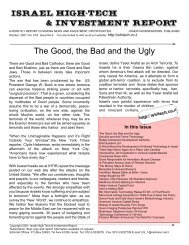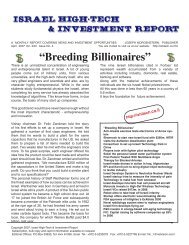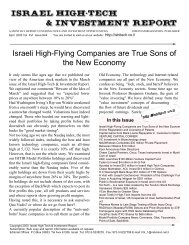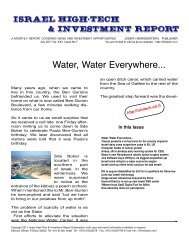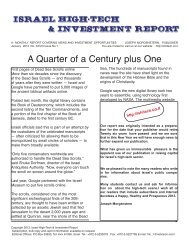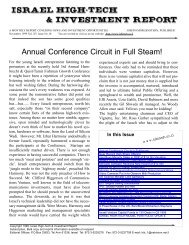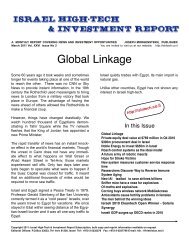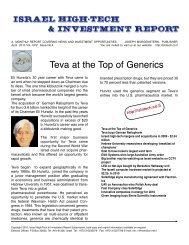Why is there only One Teva? - The Israel High Tech & Investment ...
Why is there only One Teva? - The Israel High Tech & Investment ...
Why is there only One Teva? - The Israel High Tech & Investment ...
You also want an ePaper? Increase the reach of your titles
YUMPU automatically turns print PDFs into web optimized ePapers that Google loves.
November 2004<br />
Radar Warns of Incoming Qassam<br />
Rockets<br />
Residents in Jew<strong>is</strong>h settlements in the Gaza strip will<br />
soon begin to benefit from a novel technology that<br />
affords residents a 15 to 20 second warning of an<br />
incoming Qassam rocket fired from Gaza.<br />
<strong>The</strong> system, which <strong>is</strong> connected to a public address<br />
system, was used recently for the first time and<br />
observers judged it to be successful.<br />
Known as Maamin, Hebrew for “I believe”, the system<br />
fixes the position from which a rocket <strong>is</strong> fired and<br />
<strong>is</strong>sues a warning. Using electro-optic sensors and<br />
advanced computers, Maamin <strong>is</strong> capable of<br />
pinpointing both the location of the launch and the<br />
point where the m<strong>is</strong>sile will land, in a calculation<br />
lasting. less than a second.<br />
<strong>The</strong> m<strong>is</strong>sile div<strong>is</strong>ion at Rafael <strong>Israel</strong> Armament<br />
Development Authority, developed the system and a<br />
prototype was built in six weeks following an<br />
emergency request.<br />
Maamin was developed according to specifications of<br />
the ground forces for locating snipers. Success in the<br />
development stages led to an expansion of the<br />
specifications to locating the launch sites of Qassam<br />
rockets.<br />
According to the IDF estimates, the average flight time<br />
of a Qassam <strong>is</strong> about 30 seconds, which <strong>is</strong> long<br />
enough to seek cover, according to military sources.<br />
<strong>The</strong> IDF expects to expand the capabilities of the<br />
system to enable an immediate response against<br />
those firing the rockets.<br />
Rafael CEO Giora Shalgi said the system <strong>is</strong> relatively<br />
simple. He said that with a small investment of less<br />
than $10 million it would be possible to broaden the<br />
system to cover the northern border and the Gaza<br />
Strip. According to the police officers 101 Qassam<br />
rockets have been fired so far th<strong>is</strong> year. Thirteen<br />
rockets were the upgraded Nasser 3, which has a<br />
longer range and larger warhead.<br />
Business Week: “<strong>Israel</strong> <strong>is</strong> Emerging<br />
from Financial Drought”<br />
“<strong>Israel</strong>’s high-tech sector finally <strong>is</strong> emerging from a<br />
long financial drought… <strong>The</strong> global recovery has<br />
energized <strong>Israel</strong>’s so-called ‘silicon wad<strong>is</strong>’,” stated<br />
Business Week in a recently publ<strong>is</strong>hed feature article.<br />
“<strong>The</strong>re <strong>is</strong> a buzz on the streets of Tel-Aviv about<br />
several of the major global technology players that are<br />
on the verge of cutting deals in the next few weeks.”<br />
“<strong>Why</strong> the renewed interest in <strong>Israel</strong> First, for a small<br />
country, <strong>Israel</strong> has lots of start-ups. And start-ups,<br />
unlike Western tech giants, didn’t have the luxury of<br />
cutting back R&D to get through the downturn. So the<br />
<strong>Israel</strong><strong>is</strong> kept innovating, even as the global tech<br />
industry swooned, and fighting surged between<br />
<strong>Israel</strong><strong>is</strong> and Palestinians,” writes Business Week.<br />
”Now <strong>there</strong> are lots of small survivors with leadingedge<br />
technology in areas such as Internet security,<br />
wireless broadband, and medical devices. No wonder<br />
acqu<strong>is</strong>ition activity <strong>is</strong> up by some 25% over the past<br />
year. <strong>Tech</strong> exports surged 20% in the first six months<br />
of 2004, to more than $6 billion, and the Tel-<strong>Tech</strong> 15<br />
index <strong>is</strong> up 48% in the past twelve months.<br />
”<strong>Israel</strong>i high-tech companies are also returning to Wall<br />
Street, after a long hiatus. So far th<strong>is</strong> year, three outfits<br />
Lipman Electronics Engineering (Nasdaq: LPMA;<br />
TASE: LPMA), which develops electronic payment<br />
systems; PowerDsine (Nasdaq: PDSN), a maker of<br />
integrated circuits for telecoms; and Syneron Medical<br />
(Nasdaq: ELOS) have joined the 70 plus local hightech<br />
outfits traded on Nasdaq,” Business Week points<br />
out.<br />
”<strong>The</strong>re are at least a half-dozen initial public offerings,<br />
and a number of follow-on offerings ready to go to<br />
market by the end of the year,” Lehman Brothers<br />
managing director and head of <strong>Israel</strong>i business<br />
Leonard G. Rosen was quoted as saying.<br />
<strong>The</strong> number of financing deals <strong>is</strong> increasing but 17 of<br />
31 deals in the past year have been for less than $10<br />
million. Apparently a similar situation <strong>is</strong> developing<br />
with new public offerings.<br />
Ness <strong>Tech</strong>nologies Debuts on Nasdaq<br />
Tel Aviv-based software services Ness <strong>Tech</strong>nologies<br />
(Nasdaq:NSTC) completed one of the largest initial<br />
public offerings by an <strong>Israel</strong>i firm on Nasdaq in years.<br />
Its pricing phase was a bit d<strong>is</strong>appointing for the<br />
company, which wound up ra<strong>is</strong>ing less than expected.<br />
But it was still the most impressive offering by an<br />
<strong>Israel</strong>i company on Wall Street for a long time.<br />
<strong>The</strong> final range was $12 to $14, meaning the company<br />
ra<strong>is</strong>ed between $90 million to $105 million. <strong>The</strong> firm<br />
had hopes to ra<strong>is</strong>e $120m. but settled for a lower than<br />
anticipated offering pricing.<br />
Some of its shareholders, including the Wolfson family<br />
and Warburg Pincus, decided to participate in the IPO.<br />
3



